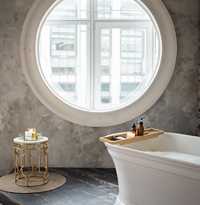Design Ideas for Minimalist Style Homes
Today’s hottest home style is minimalist. Pristine, uncluttered, refined and conducive to both physical and mental health, this style has plenty going for it. To make a minimalist home, keep an eye on the details in each room; keep colors simple, add functional pieces wherever possible, use accessories sparingly to enhance the design and functionality and bring in nature through plants and minimal furnishings. Here are some tips to save money on living expenses while creating a minimalist style home.
The focal point of any minimalist style home should be the dining room or kitchen. With no frills, just features, use dark colors for the walls and light blues, greens and browns for the trim and floor covering. Install wall fixtures with the same light colors and accents. A chandelier above the table can be a dramatic, yet subtle feature.
When choosing furniture for your minimalist style home, choose pieces that are simple but elegant; sleek, yet comforting and comfortable. Opt for cool color finishes with a natural accent – like leather for a rich, natural look. Use fabrics like chenille for a casual, yet cozy minimalism look, or try cool earth tones like wicker for a laid back, earthy vibe.
Clutter is a key aspect of creating the minimalist aesthetic style. Because of the minimalist style, you’ll want to keep your space clutter free. A good way to accomplish this is to use piles as storage for odds and ends. Or, utilize a few stuffed animals for decorative storage. Be sure to keep the clutter minimal; this gives your space a clean, organized look.
This tip is related to the minimalist interior design philosophy – keep it simple, but make it beautiful. Create visual balance by keeping similar hues in the same room. For instance, using pale green shaded walls in your living room will create a warm palette that will soften the look of your furniture. However, you don’t want your furniture to be monochromatic. Choose vibrant colors that compliment your furnishings, including upholstery and baseboards.
You can pull off a minimalist design by using textures instead of solid colors, which makes your furniture items come to life. For example, use large knick knacks on an armoire with soft cushions. Or, install leather and other textured natural materials like felt or chenille for your sofa and Ottoman pieces. Use interesting accent chairs with unique backs or interesting fabrics to pull the room together. Also, take advantage of natural materials like rattan or wicker to enhance the look of your whole space.
A minimalist style home is a reflection of its owner’s personality and lifestyle. This doesn’t mean that you have to paint everything black or stick to neutral earth tones. There are plenty of ways to add splashes of color and even some bright, sunny accents in your space. Think about accessorizing your sofa with a unique throw pillow or by using a bold piece of art to decorate a wall. Be sure to choose pieces that compliment your furniture not overwhelm it.
If you don’t like much clutter in your space, you can also choose to go with minimalism. Add as much decorative art as you can to your walls, but stay away from too many knick knacks or too many ties or scarves. Instead, focus more on neutral, earth tones that will tie the room together and bring out the character of your furnishings. To really keep your room’s clutter-free, choose just a few decorative pieces and keep your walls and floors clean and free of clutter.
Outdoor living is another great way to incorporate minimalist style homes. If you live on a larger piece of land with trees or flowers around, it makes sense to lighten up the landscape and make it inviting by bringing in natural light. You can do this through the use of well-placed windows, lighting and plants. Choose materials like pergola wood or other materials like stone that will provide natural light to your outdoors.
When choosing what pieces to add to your interior and exterior decor, take a look at how these objects relate to the minimalist style. For example, if you prefer modern pieces with clean lines, choose pieces with geometric shapes, clean finishes and flat surfaces. A good example would be art Deco mirrors that reflect light and add an element of depth. In contrast, if you love the feel of natural materials like brick, consider pieces with organic elements and accents made of natural materials like bamboo. Use color as an accent: choose colors that match or contrast with the walls and furniture that you already have. This will give your entire decor a cohesive theme.
There are also ways to create a minimalist aesthetic that doesn’t involve a lot of clutter. By keeping things organized with shelves, hooks and bins, you keep the visual clutter to a minimum and the floor space to a maximum. You can create an aesthetic that’s simple, elegant and functional in an effort to keep clutter at bay and maintain a minimalist style that looks easy and comfortable to live in!


